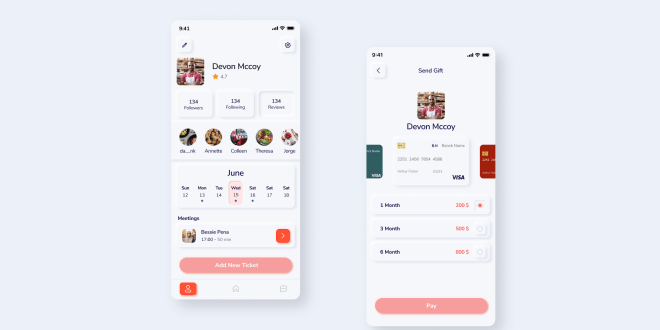In recent years, web design has evolved, and new trends have emerged, captivating both designers and users alike. One such trend that has gained popularity is “Neumorphism.” Neumorphism is a design approach that harmoniously blends elements of skeuomorphism and minimalism, resulting in visually appealing and intuitive user interfaces. In this article, we will explore the essence of Neumorphism, its impact on web design, and how it effectively marries aesthetics with functionality.
Understanding Neumorphism
Neumorphism, also known as “Soft UI,” is a visual style that aims to mimic real-world objects’ tactile and 3D appearance. It takes inspiration from skeuomorphism, which replicates real-life materials in digital interfaces, and minimalism, which emphasizes simplicity and clarity. Neumorphism incorporates subtle shadows and highlights to create a sense of depth, giving elements a “floating” effect that users find visually engaging. Neumorphism’s distinctiveness lies in its ability to strike a balance between a realistic and futuristic feel, offering a refreshing and unique user experience. The design’s softness and depth make it a perfect candidate for elevating the aesthetics of user interfaces.
The Appeal of Neumorphism
One of the primary reasons behind Neumorphism’s popularity is its ability to create a sense of familiarity while embracing modern design principles. By mimicking real-world elements, it resonates with users who appreciate the tangibility of physical objects. This nostalgic aspect of Neumorphism not only makes it appealing to users of all ages but also adds an element of comfort and ease to the interface. Moreover, Neumorphism’s subtlety and minimalism contribute to an uncluttered and organized appearance. The design’s soft shadows and gentle highlights add depth without overwhelming the user. This balance between simplicity and sophistication helps in reducing cognitive load, improving usability, and enhancing the overall user experience.
Implementing Neumorphism in Web Design
Integrating Neumorphism into web design requires a delicate approach to ensure a harmonious and visually stunning result. Here are some key considerations when using Neumorphism in your design:
Color Palette
Selecting the right color palette is essential for Neumorphism. Stick to neutral colors and gradients to create subtle shadows and highlights that complement the overall design. Avoid using overly bright or contrasting colors that could disrupt the soft and natural appearance of Neumorphic elements.
Contrast and Depth
Neumorphism thrives on contrast and depth. Use light shadows against a light background and dark shadows against a dark background to maintain the design’s subtlety. Strive to achieve a balanced composition that retains a sense of realism while staying true to minimalistic principles.
Element Distinction
To ensure an intuitive user experience, it’s crucial to differentiate Neumorphic elements from non-interactive ones. Use subtle animations or micro-interactions to provide visual cues to users, indicating the clickable or interactive nature of certain elements.
Responsiveness
Neumorphism’s elegance should be maintained across various devices and screen sizes. Implement responsive design principles to adapt the Neumorphic elements seamlessly to different resolutions without compromising on their aesthetics or functionality.
The Impact of Neumorphism on User Experience
Neumorphism’s unique blend of skeuomorphism and minimalism has a significant impact on user experience. Let’s delve into some of the ways it enhances the overall user interaction:
Intuitive Navigation
The tactile and 3D appearance of Neumorphic elements improves user navigation by providing visual cues and affordances. Users can quickly identify interactive elements and understand their purpose, reducing the learning curve and enhancing usability.
Emotional Connection
The familiarity of Neumorphic elements evokes emotional connections, especially for users who appreciate the nostalgia of physical objects. This emotional bond can lead to increased engagement and prolonged interaction with the interface.
Accessibility
Contrary to complex designs, Neumorphism’s simplicity contributes to improved accessibility. Its clear distinctions between elements and generous use of white space make it easier for users with visual impairments to navigate and comprehend the content.
Brand Differentiation
By adopting Neumorphism, a brand can stand out in the competitive digital landscape. Its distinctive appearance leaves a lasting impression on users, enhancing brand recall and recognition.
Overcoming Neumorphism Challenges
While Neumorphism has garnered praise for its aesthetics and usability, it does present some challenges that designers should be aware of:
Readability
Maintaining readability can be tricky, especially when using light text on a light background or vice versa. Designers must ensure sufficient contrast to keep the content legible without compromising the Neumorphic look.
Performance Impact
Neumorphism’s shadows and highlights can impact loading times and performance. Optimize images and CSS to ensure a smooth user experience without sacrificing visual appeal.
Visual Clutter
Overusing Neumorphic elements may lead to visual clutter, overwhelming users and distracting them from essential content. Balance is key to maintaining a clean and aesthetically pleasing design.
Final Words
In conclusion, Neumorphism serves as an innovative and captivating design approach, blending skeuomorphism’s realism with minimalism’s elegance. Its ability to evoke nostalgia and create an emotional connection with users makes it a valuable trend in modern web design. When implemented thoughtfully and optimized for performance, Neumorphism can undoubtedly elevate the user experience and leave a lasting impact on visitors.
Frequently Asked Questions
Q1: Is Neumorphism suitable for all types of websites?
A: While Neumorphism adds a touch of elegance to many interfaces, its effectiveness may vary based on the website’s purpose and target audience. It works exceptionally well for websites that aim to evoke emotions, such as portfolios, personal blogs, and creative websites. However, for highly functional websites that prioritize quick task completion, a more streamlined design approach might be more suitable.
Q2: Can Neumorphic elements affect website loading speed?
A: Yes, Neumorphic elements, especially if not optimized correctly, can impact loading times and overall performance. To mitigate this, designers should optimize images, CSS, and other assets to ensure a smooth and speedy user experience.
Q3: What are the alternatives to Neumorphism in web design?
A: If Neumorphism doesn’t align with your website’s goals or brand identity, there are several alternative design styles worth exploring. Material Design, Flat Design, and Glassmorphism are some popular alternatives that cater to different aesthetics and user experiences.
Q4: How can I create a visually balanced Neumorphic design?
A: Achieving a visually balanced Neumorphic design involves careful attention to contrast, color, and depth. Use subtle shadows and highlights to provide depth without overwhelming the user. Ensure a harmonious color palette that complements the overall design and maintains a sense of realism.
Q5: Is Neumorphism accessible for users with visual impairments?
A: Neumorphism can be made accessible for users with visual impairments through careful design considerations. Ensuring sufficient contrast between elements and utilizing appropriate aria-labels and descriptive alt text for non-text content are essential steps in improving accessibility.
 webfily
webfily



